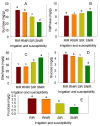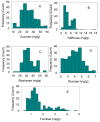Soybean Seed Sugars: A Role in the Mechanism of Resistance to Charcoal Rot and Potential Use as Biomarkers in Selection
- PMID: 36679106
- PMCID: PMC9864826
- DOI: 10.3390/plants12020392
Soybean Seed Sugars: A Role in the Mechanism of Resistance to Charcoal Rot and Potential Use as Biomarkers in Selection
Abstract
Charcoal rot, caused by Macrophomina phaseolina, is a major soybean disease resulting in significant yield loss and poor seed quality. Currently, no resistant soybean cultivar is available in the market and resistance mechanisms to charcoal rot are unknown, although the disease is believed to infect plants from infected soil through the roots by unknown toxin-mediated mechanisms. The objective of this research was to investigate the association between seed sugars (sucrose, raffinose, stachyose, glucose, and fructose) and their role as biomarkers in the soybean defense mechanism in the moderately resistant (MR) and susceptible (S) genotypes to charcoal rot. Seven MR and six S genotypes were grown under irrigated (IR) and non-irrigated (NIR) conditions. A two-year field experiment was conducted in 2012 and 2013 at Jackson, TN, USA. The main findings in this research were that MR genotypes generally had the ability to maintain higher seed levels of sucrose, glucose, and fructose than did S genotypes. Conversely, susceptible genotypes showed a higher level of stachyose and lower levels of sucrose, glucose, and fructose. This was observed in 6 out of 7 MR genotypes and in 4 out of 6 S genotypes in 2012; and in 5 out of 7 MR genotypes and in 5 out of 6 S genotypes in 2013. The response of S genotypes with higher levels of stachyose and lower sucrose, glucose, and fructose, compared with those of MR genotypes, may indicate the possible role of these sugars in a defense mechanism against charcoal rot. It also indicates that nutrient pathways in MR genotypes allowed for a higher influx of nutritious sugars (sucrose, glucose, and fructose) than did S genotypes, suggesting these sugars as potential biomarkers for selecting MR soybean plants after harvest. This research provides new knowledge on seed sugars and helps in understanding the impact of charcoal rot on seed sugars in moderately resistant and susceptible genotypes.
Keywords: charcoal rot; disease resistance; seed composition; seed nutrition; seed quality; seed sugars; soybean seed.
Conflict of interest statement
The authors declare no conflict of interest.
Figures



Similar articles
-
Effects of Charcoal Rot on Soybean Seed Composition in Soybean Genotypes That Differ in Charcoal Rot Resistance under Irrigated and Non-Irrigated Conditions.Plants (Basel). 2021 Aug 29;10(9):1801. doi: 10.3390/plants10091801. Plants (Basel). 2021. PMID: 34579334 Free PMC article.
-
Severity of charcoal rot disease in soybean genotypes inoculated with Macrophomina phaseolina isolates differs among growth environments.Plant Dis. 2025 Mar 16. doi: 10.1094/PDIS-10-24-2230-RE. Online ahead of print. Plant Dis. 2025. PMID: 40090013
-
Charcoal Rot Severity and Soybean Yield Responses to Planting Date, Irrigation, and Genotypes.Plant Dis. 2023 Feb;107(2):413-421. doi: 10.1094/PDIS-06-22-1329-RE. Epub 2023 Feb 16. Plant Dis. 2023. PMID: 36794968
-
Facets of rhizospheric microflora in biocontrol of phytopathogen Macrophomina phaseolina in oil crop soybean.Arch Microbiol. 2021 Mar;203(2):405-412. doi: 10.1007/s00203-020-02046-z. Epub 2020 Sep 23. Arch Microbiol. 2021. PMID: 32965527 Review.
-
Molecular interaction of charcoal rot pathogenesis in soybean: a complex interaction.Plant Cell Rep. 2021 Oct;40(10):1799-1812. doi: 10.1007/s00299-021-02747-9. Epub 2021 Jul 7. Plant Cell Rep. 2021. PMID: 34232377 Review.
Cited by
-
Susceptibility of the Most Popular Soybean Cultivars in South-East Europe to Macrophomina phaseolina (Tassi) Goid.Plants (Basel). 2023 Jun 28;12(13):2467. doi: 10.3390/plants12132467. Plants (Basel). 2023. PMID: 37447028 Free PMC article.
-
Accessing the specialized metabolome of actinobacteria from the bulk soil of Paullinia cupana Mart. on the Brazilian Amazon: a promising source of bioactive compounds against soybean phytopathogens.Braz J Microbiol. 2024 Jun;55(2):1863-1882. doi: 10.1007/s42770-024-01286-1. Epub 2024 Feb 29. Braz J Microbiol. 2024. PMID: 38421597 Free PMC article.
References
-
- Hymowitz T., Collins F.I. Variability of sugar content of seed of Glycine max (L.) Merr. and G. soja Serb. and Zucco. Agron. J. 1974;66:239–240. doi: 10.2134/agronj1974.00021962006600020017x. - DOI
-
- Hou A., Chen P., Alloatti J., Li D., Mozzoni L., Zhang B., Shi A. Genetic Variability of Seed Sugar Content in Worldwide Soybean Germplasm Collections. Crop Sci. 2009;49:903–912. doi: 10.2135/cropsci2008.05.0256. - DOI
-
- Bellaloui N., Smith J.R., Gillen A.M., Ray J.D. Effect of Maturity on Seed Sugars as Measured on Near-Isogenic Soybean (Glycine max) Lines. Crop Sci. 2010;50:1978–1987. doi: 10.2135/cropsci2009.10.0596. - DOI
-
- Liu K. Soybeans: Chemistry, Technology and Utilization. Springer US; New York, NY, USA: 1997.
-
- Wilson L.A. Soy foods. In: Erickson D.R., editor. Practical Handbook of Soybean Processing and Utilization. 1st ed. AOCS Press; Urbana, IL, USA: 1995. pp. 428–459.
Grants and funding
LinkOut - more resources
Full Text Sources
Miscellaneous

